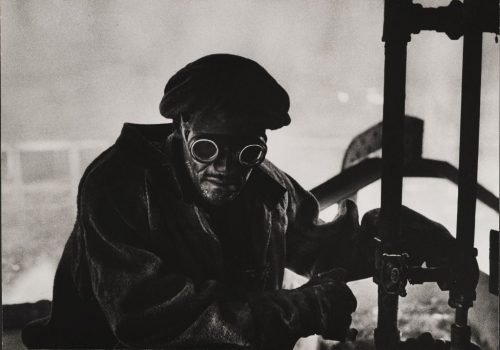One-hundred years after the birth of W. Eugene Smith (1918-1978), Fondazione MAST (Bologna) presents Italy’s first exhibition devoted to the work the American photographer started on Pittsburgh (Pennsylvania, USA) in 1955.
The exhibition offers a significant selection from Smith’s vast portrait of this dynamic American city at the height of its economic development. It focuses on the main nucleus of this challenging project: 170 vintage prints from the collection of the Carnegie Museum of Art in Pittsburgh on the city and America during the 1950s, “a time filled with light, shadow and promises of happiness and progress”, the exhibition curator Urs Stahel, says. Somehow, observing the images at MAST is like looking at the book Smith never managed to publish.
Indeed, the project, which Smith considered the most ambitious of his career as well as a never ended one, marked a turning point in his life. He achieved success and fame as a photojournalist documenting World War II for Life magazine (in those pre-television days Life was a dominant cultural force as well as a major news source), but Smith “freed himself from the restrictions of commissioned work and began instead to look for greater depth and authenticity, driven by his desire to seek out absolute truths, to be fully present and prepared during the rare moments in which the truth of life manifests itself in worldly phenomena. This break with the press (…) initiated a new chapter in his life“, Stahel adds.
Eugene Smith devoted himself to photography with total freedom. ‘He wrestled with the representation of the absolute. Rather than merely documenting the world, he wanted, at least in some photographs, to grasp, to capture the very essence of human existence”, Stahel explained.
While he was joining Magnum Photos, his first project was to spend a couple of months taking around a hundred photographs of Pittsburgh for a publication celebrating the city’s bicentennial, also documenting the growth of its industries, mainly the steel industry. Smith was fascinated by the City of Steel, the faces of the workers, its factories and details and contradictions of its social fabric. He aimed to create a comprehensive portrait of the city, showing all the “elements of an evolving, conflicting modern world – elements that first entered his photography in a much different setting during World War II – on display in everyday Pittsburgh: simultaneous images of (…) production and destruction, past and present, human and machine, the individual and collective, the ordinary and spectacular” as Sam Stephenson wrote in his book dealing with Smith’s Pittsburg Project. In some way Smith’s work can be thought of like a medieval encyclopedia, that was supposed to include all universal knowledge within its pages.
“Don’t expect a point-by-point hand-led tour. This is the experience an intensely curious visitor (perhaps a new resident) might have ”, Smith wrote as a note to himself as he began his Pittsburgh project.
He tried to weave a kind of tapestry made of so many images and elements in order to communicate the essence of the story. “Rather than aiming to describe the world, his photos wanted to incorporate it; rather than trying to produce a copy of it, they wanted to bring it to life”, Stahel says. This simple brief thus transformed into one of the most important projects of his life. Pittsburgh became like an obsession: he went on shooting for almost three years, then spent the rest of his life struggling with the almost 20,000 negatives and 2,000 master prints, trying to create the “definitive” book on Pittsburgh, without ever entirely succeeding.
Only a small part of his project was published in the 1959 Photography Annual. It was the only magazine Smith agreed to work with, for it guaranteed him absolute control over the thirty-six-page feature (he rejected lucrative offers from Life and other magazines). Smith’s priority remained for years to publish an entire volume on Pittsburgh. The selection of images displayed in the MAST PhotoGallery offers an intense, representative view of this project, about which Smith himself observed: ‘The main problem, I think, is that there is no end to such a subject as Pittsburgh and no way to finish it.’
The exhibition is organised by the Fondazione MAST in collaboration with Carnegie Museum of Art, Pittsburgh, Pennsylvania.
Paola Sammartano
Paola Sammartano is a journalist specialized in arts and photography based in Milan, Italy
Eugene Smith: Pittsburgh Portrait of an Industrial City
May 17 to September 16, 2018
MAST.Gallery
Via Speranza 42, Bologna
Italy
















